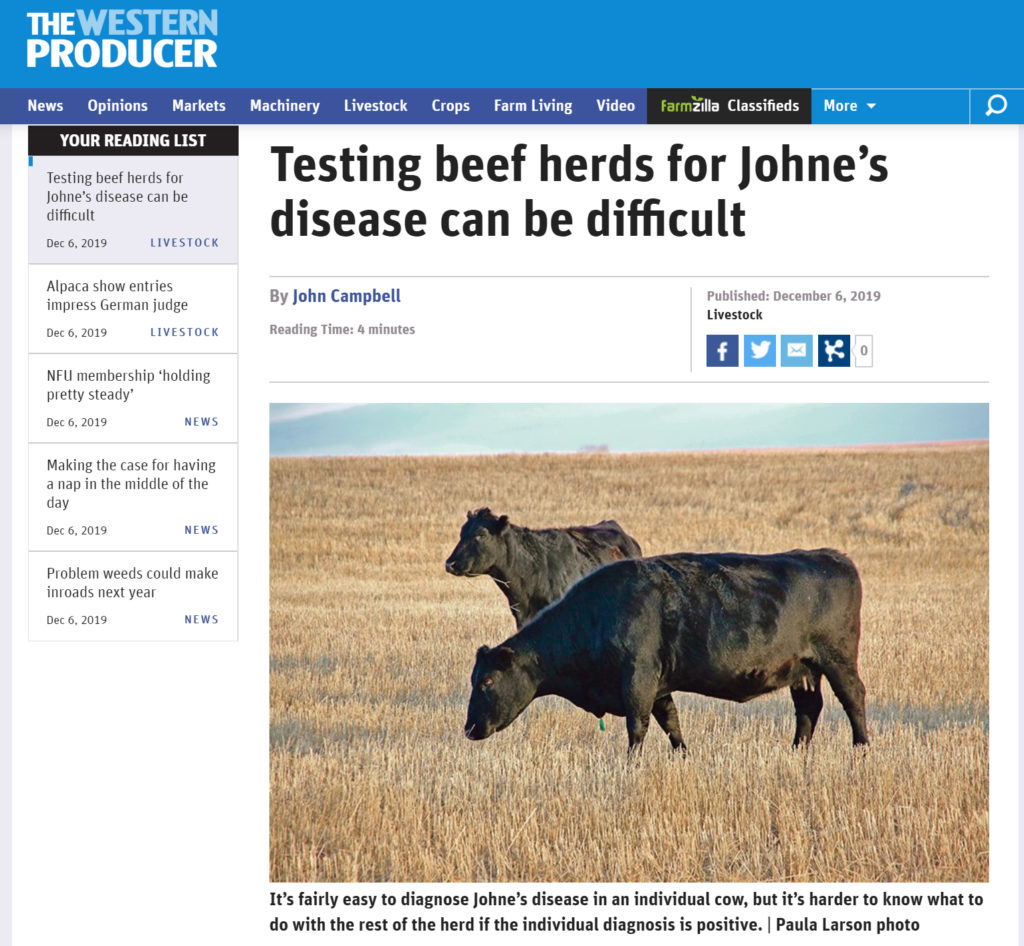John Campbell published an article in the December 6 issue of The Western Producer titled: Testing beef herds for Johne’s disease can be difficult. Interestingly, he begins his article stating: “Every year, I seem to write another article about Johne’s disease. It is one of the most common topics of phone calls and questions that I receive from veterinarians and producers.”
It’s very helpful that this article written for beef cattle producers calls attention to Johne’s disease. However, it is more pessimistic about diagnostic testing than necessary.
This news posting offers an alternative perspective.
Mr. Campbell describes a hypothetical 1,000 cow herd with a 10% true MAP infection rate. He analyzes what would occur using a blood test (ELISA) with a sensitivity and specificity of 30% and 99%, respectively. He explains that on a single herd test there will be too many false-negative test (7 of the 10 MAP-infected cows would be missed). In his example, he claims there also would be too many false-positive test results (9 cows that are truly not MAP-infected would test positive) resulting in too many mistakenly culled cows. There are several problems with this analysis.
First, the beef cattle herds that should be testing are those sell breeding stock, often called seedstock producers. For commercial cow-calf producers a such a testing program is good for animal health and welfare but hard to justify economically. For seedstock producers, eradicating MAP infections or proving herds are not MAP-infected must be a business objective to avoid spreading MAP infections to other herds.
Second, beef seedstock herds should not be using a blood test (ELISA). Rather they should use a test with higher sensitivity and specificity namely the direct fecal PCR assay. The high throughput PCR assay used in Australia has a reported sensitivity and specificity of 60.4% and 99.6%, respectively (Plain, 2014).
Also, ELISAs are screening tests and most experts recommend doing a confirmatory test (culture or PCR) on all ELISA-positive animals before making a decision to cull the cow. Especially if the cow is valuable.
Had Mr. Campbell used fecal PCR as the test in his example, only 4 of the 10 MAP-infected cows would be missed on a single whole herd test and these so called false-negative cows would be animals that were shedding few or no MAP in their feces, meaning they are not infectious. These animals would likely be detected in the next annual herd test. The false-positive rate would be 0.4% (1.00 minus specificity) or 3 – 4 cows (890 non-infected cows x 0.4% = 3.5).
Not only is a direct fecal PCR the test of choice, but this assay is more economical because it can be done on pooled fecal samples (the lab does the pooling). Until recently, the standard pooling method mixed fecal samples from 5 cows into a single pool that was then tested by PCR. This month, Australian researchers showed that this can be increased to 10 animal per pool (Ly, 2019).
At the Wisconsin Veterinary Diagnostic Laboratory the ELISA cost is $6/sample and the pooled PCR is $34/pool, or $6.80/cow, using pools of 5, and it would be only $3.40/cow, using pools of 10. Some additional costs would be incurred to run a confirmatory test on ELISA-positive cows and to test individual cows in the PCR-positive fecal pools.
____________
In summary, pooled fecal PCR is the test of choice for beef cattle seedstock herds. This assay provides twice the diagnostic sensitivity (rate of detecting MAP-infected cows) and higher diagnostic specificity (fewest false-positives) at a cost that is comparable to or lower than that of the ELISA blood test. Additionally, the fecal PCR provides numerical results that indicate which cows are shedding the most MAP, i.e. those that are most infectious and should be culled first. This is also true for breeders of sheep, goats, dairy cows and other ruminants.
